2007 CHEVROLET MALIBU MAXX ECU
[x] Cancel search: ECUPage 89 of 510
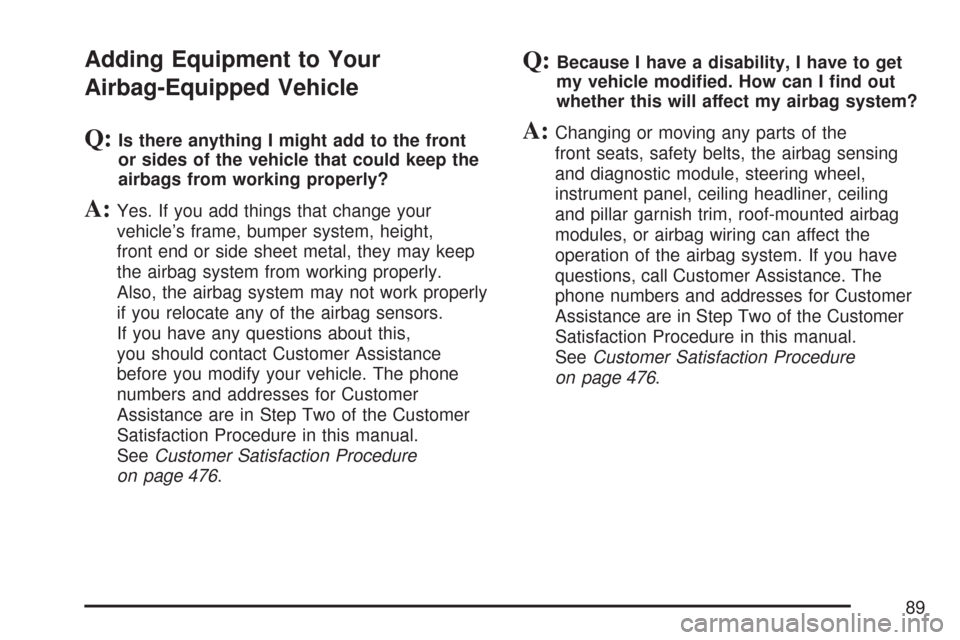
Adding Equipment to Your
Airbag-Equipped Vehicle
Q:Is there anything I might add to the front
or sides of the vehicle that could keep the
airbags from working properly?
A:Yes. If you add things that change your
vehicle’s frame, bumper system, height,
front end or side sheet metal, they may keep
the airbag system from working properly.
Also, the airbag system may not work properly
if you relocate any of the airbag sensors.
If you have any questions about this,
you should contact Customer Assistance
before you modify your vehicle. The phone
numbers and addresses for Customer
Assistance are in Step Two of the Customer
Satisfaction Procedure in this manual.
SeeCustomer Satisfaction Procedure
on page 476.
Q:Because I have a disability, I have to get
my vehicle modi�ed. How can I �nd out
whether this will affect my airbag system?
A:Changing or moving any parts of the
front seats, safety belts, the airbag sensing
and diagnostic module, steering wheel,
instrument panel, ceiling headliner, ceiling
and pillar garnish trim, roof-mounted airbag
modules, or airbag wiring can affect the
operation of the airbag system. If you have
questions, call Customer Assistance. The
phone numbers and addresses for Customer
Assistance are in Step Two of the Customer
Satisfaction Procedure in this manual.
SeeCustomer Satisfaction Procedure
on page 476.
89
Page 93 of 510
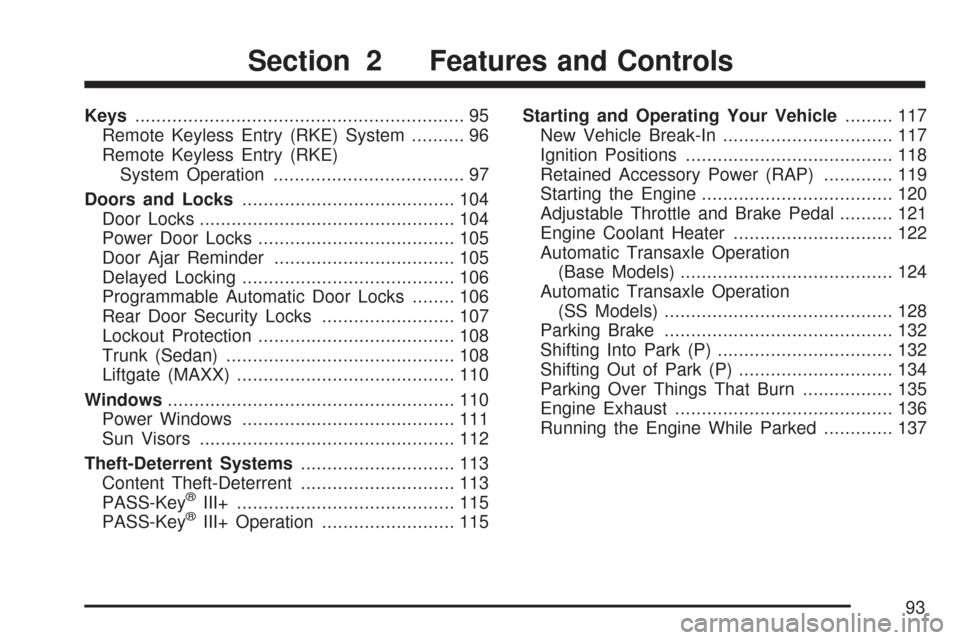
Keys.............................................................. 95
Remote Keyless Entry (RKE) System.......... 96
Remote Keyless Entry (RKE)
System Operation.................................... 97
Doors and Locks........................................ 104
Door Locks................................................ 104
Power Door Locks..................................... 105
Door Ajar Reminder.................................. 105
Delayed Locking........................................ 106
Programmable Automatic Door Locks........ 106
Rear Door Security Locks......................... 107
Lockout Protection..................................... 108
Trunk (Sedan)........................................... 108
Liftgate (MAXX)......................................... 110
Windows...................................................... 110
Power Windows........................................ 111
Sun Visors................................................ 112
Theft-Deterrent Systems............................. 113
Content Theft-Deterrent............................. 113
PASS-Key
®III+......................................... 115
PASS-Key®III+ Operation......................... 115Starting and Operating Your Vehicle......... 117
New Vehicle Break-In................................ 117
Ignition Positions....................................... 118
Retained Accessory Power (RAP)............. 119
Starting the Engine.................................... 120
Adjustable Throttle and Brake Pedal.......... 121
Engine Coolant Heater.............................. 122
Automatic Transaxle Operation
(Base Models)........................................ 124
Automatic Transaxle Operation
(SS Models)........................................... 128
Parking Brake........................................... 132
Shifting Into Park (P)................................. 132
Shifting Out of Park (P)............................. 134
Parking Over Things That Burn................. 135
Engine Exhaust......................................... 136
Running the Engine While Parked............. 137
Section 2 Features and Controls
93
Page 107 of 510
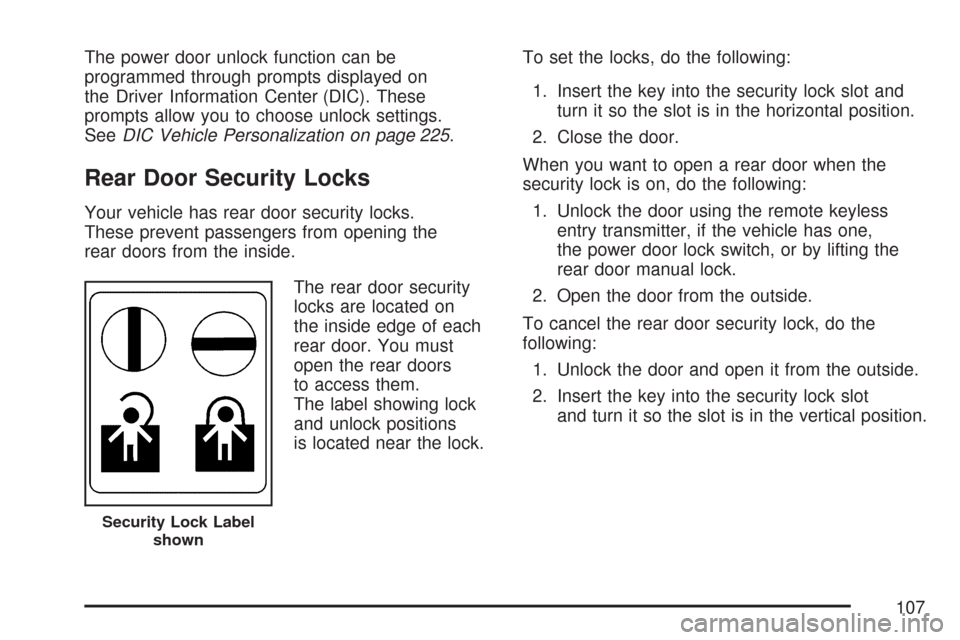
The power door unlock function can be
programmed through prompts displayed on
the Driver Information Center (DIC). These
prompts allow you to choose unlock settings.
SeeDIC Vehicle Personalization on page 225.
Rear Door Security Locks
Your vehicle has rear door security locks.
These prevent passengers from opening the
rear doors from the inside.
The rear door security
locks are located on
the inside edge of each
rear door. You must
open the rear doors
to access them.
The label showing lock
and unlock positions
is located near the lock.To set the locks, do the following:
1. Insert the key into the security lock slot and
turn it so the slot is in the horizontal position.
2. Close the door.
When you want to open a rear door when the
security lock is on, do the following:
1. Unlock the door using the remote keyless
entry transmitter, if the vehicle has one,
the power door lock switch, or by lifting the
rear door manual lock.
2. Open the door from the outside.
To cancel the rear door security lock, do the
following:
1. Unlock the door and open it from the outside.
2. Insert the key into the security lock slot
and turn it so the slot is in the vertical position.
Security Lock Label
shown
107
Page 109 of 510
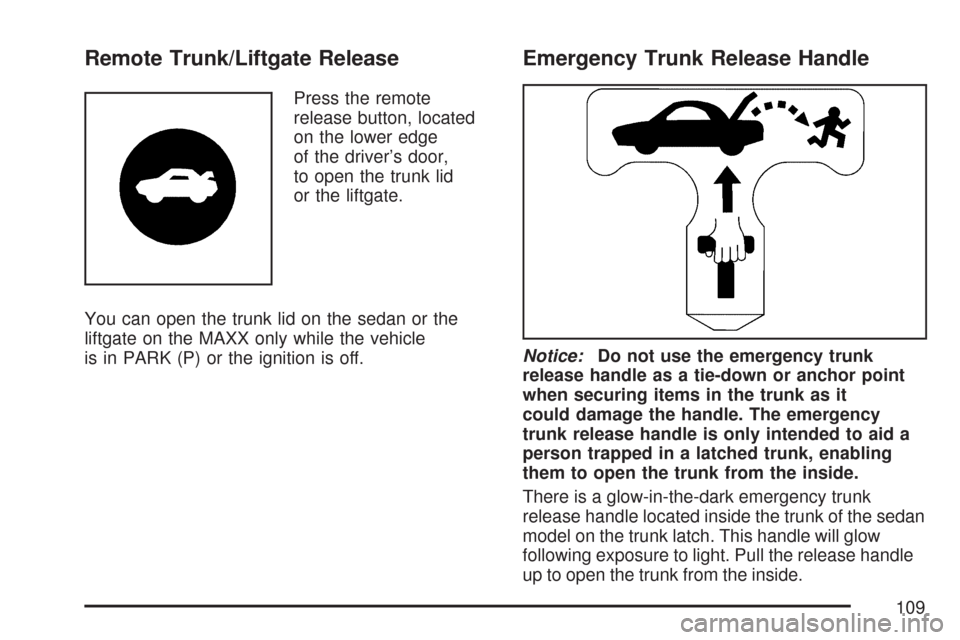
Remote Trunk/Liftgate Release
Press the remote
release button, located
on the lower edge
of the driver’s door,
to open the trunk lid
or the liftgate.
You can open the trunk lid on the sedan or the
liftgate on the MAXX only while the vehicle
is in PARK (P) or the ignition is off.
Emergency Trunk Release Handle
Notice:Do not use the emergency trunk
release handle as a tie-down or anchor point
when securing items in the trunk as it
could damage the handle. The emergency
trunk release handle is only intended to aid a
person trapped in a latched trunk, enabling
them to open the trunk from the inside.
There is a glow-in-the-dark emergency trunk
release handle located inside the trunk of the sedan
model on the trunk latch. This handle will glow
following exposure to light. Pull the release handle
up to open the trunk from the inside.
109
Page 113 of 510

Theft-Deterrent Systems
Vehicle theft is big business, especially in some
cities. Although your vehicle has a number of
theft-deterrent features, we know that nothing we
put on it can make it impossible to steal.
Content Theft-Deterrent
Your vehicle may have
a content theft-deterrent
alarm system.
Arming the System
With the ignition off, you can arm the system by
doing any one of the following:
Press the remote keyless entry transmitter
lock button.
Press the power door lock switch while the
driver’s door is open.The system will arm either:
Thirty seconds after all the doors and the
liftgate (MAXX) are closed.
Sixty seconds with any door open.
If you press the lock button on the remote keyless
entry transmitter a second time while all the
doors and liftgate are closed, the system will
arm immediately. The system will still arm
in sixty seconds if a door or liftgate is open.
When the opened door or liftgate is closed,
it will also become armed.
The security light, located on the instrument
panel cluster, will turn on to indicate that arming
has been initiated. Once the system is armed, the
security light will �ash once every three seconds.
If the security light is �ashing twice per second,
this means that a door or the liftgate is open.
If you do not want to arm the system, you may
lock the car with the lock knob on the doors.
113
Page 114 of 510

Disarming the System
You can disarm the system by doing any one of
the following:
Press the remote keyless entry transmitter
unlock button.
Turn the ignition on.
Turn the driver’s door key lock cylinder
counterclockwise.
Once the system is disarmed, the security light
will stop �ashing.
How the System Alarm is Activated
If the system is armed, it can be activated
by either:
Opening the driver’s door or liftgate
(MAXX model). This will cause a
ten second pre-alarm chirp followed by a
thirty second full alarm of horn and lights.
Opening any other door. This will immediately
cause a full alarm of horn and lights for
thirty seconds.
When an alarm event has �nished, the system
will re-arm itself automatically.
How to Turn Off the System Alarm
To turn off the system alarm, do one of the
following:
Press the lock button on the remote keyless
entry transmitter. The system will then
re-arm itself.
Press the unlock button on the remote keyless
entry transmitter. This will also disarm the
system.
Insert the key in the driver’s door key lock
cylinder and turn it counterclockwise.
This will also disarm the system.
Insert the key in the ignition and turn it on.
This will also disarm the system.
How to Detect a Tamper Condition
If you hear three chirps when you press the
unlock or lock buttons on the remote keyless
entry transmitter, it means that the content theft
security system alarm was triggered previously.
114
Page 115 of 510
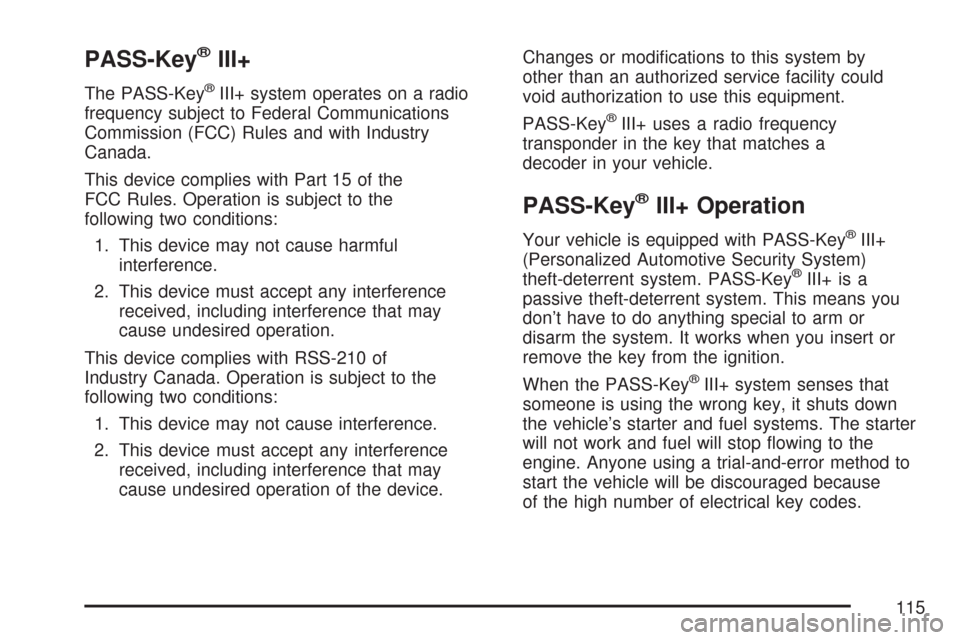
PASS-Key®III+
The PASS-Key®III+ system operates on a radio
frequency subject to Federal Communications
Commission (FCC) Rules and with Industry
Canada.
This device complies with Part 15 of the
FCC Rules. Operation is subject to the
following two conditions:
1. This device may not cause harmful
interference.
2. This device must accept any interference
received, including interference that may
cause undesired operation.
This device complies with RSS-210 of
Industry Canada. Operation is subject to the
following two conditions:
1. This device may not cause interference.
2. This device must accept any interference
received, including interference that may
cause undesired operation of the device.Changes or modi�cations to this system by
other than an authorized service facility could
void authorization to use this equipment.
PASS-Key
®III+ uses a radio frequency
transponder in the key that matches a
decoder in your vehicle.
PASS-Key®III+ Operation
Your vehicle is equipped with PASS-Key®III+
(Personalized Automotive Security System)
theft-deterrent system. PASS-Key
®III+ is a
passive theft-deterrent system. This means you
don’t have to do anything special to arm or
disarm the system. It works when you insert or
remove the key from the ignition.
When the PASS-Key
®III+ system senses that
someone is using the wrong key, it shuts down
the vehicle’s starter and fuel systems. The starter
will not work and fuel will stop �owing to the
engine. Anyone using a trial-and-error method to
start the vehicle will be discouraged because
of the high number of electrical key codes.
115
Page 116 of 510

When trying to start the vehicle if the engine does
not start and the security light comes on, the
key may have a damaged transponder. Turn the
ignition off and try again.
If the engine still does not start, and the key
appears to be undamaged, try another ignition
key. At this time, you may also want to check the
fuse, seeFuses on page 446. If the engine still
does not start with the other key, your vehicle
needs service. If your vehicle does start, the
�rst key may be faulty. See your dealer who
can service the PASS-Key
®III+ to have a new
key made. In an emergency, contact Chevrolet
Roadside Assistance. SeeRoadside Assistance
Program on page 481for more information.
It is possible for the PASS-Key
®III+ decoder
to “learn” the transponder value of a new
or replacement key. Up to 10 additional keys may
be programmed for the vehicle. The following
procedure is for programming additional keys only.
If all the currently programmed keys are lost or
do not operate, you must see your dealer or
a locksmith who can service PASS-Key
®III+ to
have keys made and programmed to the system.See your GM dealer or a locksmith who can
service PASS-Key
®III+ to get a new key blank
that is cut exactly as the ignition key that operates
the system.
To program the new key do the following:
1. Verify that the new key has “+” stamped on it.
2. Insert the already programmed key in the
ignition and start the engine. If the engine
will not start, see your dealer for service.
3. After the engine has started, turn the key to
off, and remove the key.
4. Insert the key to be programmed and turn
it to on within �ve seconds of removing the
original key.
5. The security light will turn off once the key
has been programmed. It may not be
apparent that the security light went on due to
how quickly the key is programmed.
6. Repeat Steps 1 through 5 if additional keys
are to be programmed.
116